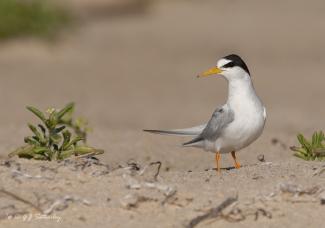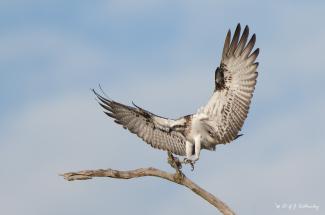Over 200 animal and plant species in the Tuggerah Lakes catchment are categorised as ‘threatened, vulnerable and endangered’. Their populations have been placed under a lot of stress because of various human-related activities. Some species have lost their habitat due to new developments and land farming, as well as the threat of introduced plants. A further strain on the local animal and plant populations occurs when pollution enters the waterways.
Fauna species
White's Seahorse
Hippocampus whitei, commonly known as White’s Seahorse or Sydney Seahorse, is a medium-sized marine seahorse that was recently listed as endangered in NSW. It has been found living on the Central Coast in Brisbane Water, Tuggerah Lakes and Lake Macquarie along with numerous other species of protected pipefish. White’s Seahorse is endemic to the Southwest Pacific region, which means that it is not naturally found elsewhere in the world. These beautiful little fishes with hard bony armour on their bodies live in the water’s seagrass beds and feed on small invertebrates. Central Coast Council is working with the University of Newcastle to monitor their habitat and behaviour and help to improve their chance of survival.
Regent Honeyeater
The Regent Honeyeater, named for its striking yellow-and-black plumage, is a critically endangered bird native to South-Eastern Australia. Land clearing and competition from the introduced animal species have placed it in imminent danger of extinction due to less available habitat and food.
Spotted-tailed Quoll
The Spotted-tailed Quoll is a carnivorous marsupial the size of a domestic cat, found on the Central Coast and native to Australia. This fascinating animal has recently become endangered. A loss of habitat and major changes across the land, as well as the influence of introduced predators such as foxes, have all contributed to its declining population.
Little Tern
The Little Tern is another endangered species in NSW. Between October and December, these small migratory seabirds travel from eastern Asia to the south-east of Australia to nest and breed. They build their nests in the sand on the beaches, often in precarious spots that can be disturbed by people and domestic pets. Little Terns will abandon their eggs when distressed, which threatens their population numbers. Central Coast Council and the National Parks and Wildlife Service (NPWS) strive to protect the nesting birds by building fences around their breeding sites to keep people and animal predators away. Most years, Little Terns will nest on the Karagi Point sand spit at the Entrance. It is best to watch out for any potential egg-laying birds and maintain a safe distance from them. This way, we can protect this bird's successful breeding and contribute to their survival.
The Eastern Osprey
This species of medium-sized fish-eating raptor has also been listed as vulnerable in NSW. The Eastern Osprey can plunge underwater with the feet forward, ready to catch fish with its talons. Although Eastern Ospreys can travel long distances, they tend to come back to the same nesting sites. The loss of safe breeding spots, along with contaminated fish and growing incidents of entanglement in fishing gear, have all put this bird on the 'threatened species' list.
Cauliflower Soft Coral
The Cauliflower Soft Coral (Dendronephthya australis) was listed as Endangered in 2020. This rare soft coral is known to occur in the tidal reach of Brisbane Water along with a few other discrete locations on the NSW coast. The coral was discovered by local scientists and is protected by law in NSW.
Flora species
Biconvex Paperbark (Melaleuca biconvexa)
Biconvex Paperbark is a vulnerable shrub or a small tree that grows up to 10 metres tall and blooms once a year, in September and October, producing small clusters of white flowers. It prefers damper conditions, so can be found around the wetlands, streams and lakes of the Central Coast. Its bark is that of a typical paperbark. For thousands of years, the local Aboriginal people have used Biconvex Paperbark as a medicine to treat headaches and colds.
The Magenta Lilly Pilly (Syzygium paniculatum)
The Magenta Lilly Pilly, also known as Magenta Cherry, is a vulnerable rainforest tree that can grow up to 8 metres tall. Its bark is flaky and the leaves are shiny, with a dark-green hue above and paler tones underneath. Each year, between November and February, the plants of Magenta Lilly Pilly produce white flower clusters at the end of each branch. Their petals are small and feature prominent long stamens. This plant also boasts edible, single-seeded fruit, mostly in magenta pink but sometimes also white or purple, which mature in May.
Somersby Mintbush (Prostanthera junonis)
The Somersby Mintbush is a low spreading shrub native to NSW and considered endangered here. It grows up to 1 metre high and features branches that appear wiry and often stretch out on the ground. Depending on the weather and local site conditions, the Somersby Mintbush produces pale pink flowers, blooming between October and mid-December. Where the vegetation is denser, the plants have long spindly branches, which weave through other plants.
Charmhaven Apple (Angophora inopina)
The Charmhaven Apple is a vulnerable species of small, often multi-stemmed tree growing up to 8 metres high and endemic to the Central Coast of NSW. It features a persistent, shortly fibrous bark and produces glossy green leaves, white flowers and a pear-shaped fruit that offers an important food source for the local birds. This tree flowers between mid-December and mid-January, but its blooms tend to be weak and irregular.
Wyong Sun Orchid (Thelymitra adorata)
The Wyong Sun Orchid, sometimes called the Praying Sun Orchid, is a critically endangered ground orchid that can grow up to 60 cm tall. This colourful species has droopy green leaves with a purplish base. The flowering stem, which usually emerges in September, is a dark bluish-purple. Its flowers are pale to dark blue and fragrant, but will only open in warm and sunny weather. The Wyong Sun Orchid is another unique species endemic to the Central Coast region. It can be found around Wyong, Warnervale and Wyongah areas.



